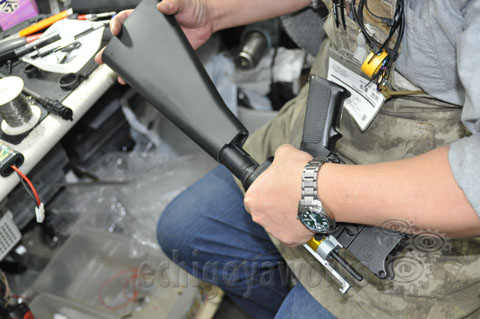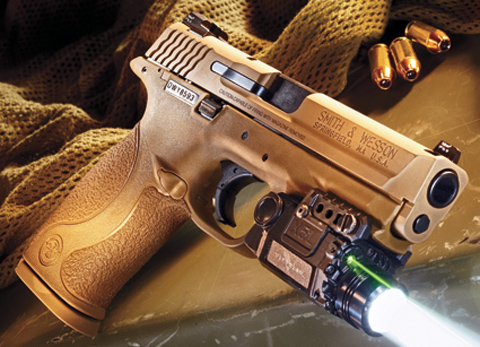2012年04月02日
98 Bravo Mountain Warfare Machine
私たちのブログを訪問していただきありがとうございます。あなたがお持ちの場合DIYの要求は私達に電子メールを送信してください。
Barrett’s handy .338 LM gives sub-MOA bite out to 1,500 YDS less the BMG kick!

Generally speaking, I test somewhere between a dozen and two-dozen new rifles a year, and of that number there are usually a couple that I anticipate with special interest. For some time, the rifle I have anticipated the most has been the Barrett 98 Bravo. The overall quality and accuracy of Barrett rifles is well known, and I have friends in numerous special operations or counter-terror units who consider their Barrett “50s” among their most effective tools. I agree entirely, having fired Barrett .50 BMG rifles and been very impressed. However, my favorite long-range round is the .338 Lapua, which offers an operator the ability to range out to at least 1,200 to 1,500 yards in the antipersonnel role and still be effective in the anti-materiel role against many hard targets.

The Barrett 98 actually started its life as a semi-auto back in 1998, but never went into full production. Ronnie Barrett’s son Chris revived the 98 project as a bolt gun. Steve Woods Photo
Very important for operators who may be inserted into their AO (Area of Operations) then have to climb or walk to their shooting position, .338 Lapua rifles are generally more portable. They are still not as light as a typical M4, though I have seen M4s with so much gear added that they might be approaching the weight of some .338 Lapua rifles. But a .338 Lapua rifle may be easily humped into action—in fact, some special ops units have made the .338 their default sniping round instead of the .308 or .300 Win Mag.

This view from behind the 98 Bravo illustrates how easy it is to see the screen of the BORS while maintaining a shooting position. For maximum comfort and speed, the ergonomic grip pairs well with the hefty bolt knob.
Barrett’s 98 Bravo is an excellent platform for the .338 Lapua round. Unlike many other .338 Lapua rifles that are based on sporting rifles, the 98 Bravo was designed from the beginning as a tactical rifle. As a side note, this is the case with the .338 Lapua cartridge as well, which was purpose-designed as a long-range man-killer. Development began on the 98 Bravo over a decade ago, but it wasn’t until recently that the rifle was considered fully ready for deployment with military and law enforcement tactical units. Speaking of law enforcement units, there are some—especially units such as the FBI HRT or state police tactical units—that may be deployed in areas where very long shots might be required. Because of the words “Machine Gun” in the designation, a .50 BMG (Browning Machine Gun) rifle might be harder to sell to administrators than would a .338 Lapua.

A sniper team can do some anti-materiel damage with the .338 LM. The spotter can quickly call the shots for the sniper, allowing him to adjust for a follow-up shot.
By Leroy Thompson
BLOG ARCHIVES

2012年04月02日
Remington ACR update
私たちのブログを訪問していただきありがとうございます。あなたがお持ちの場合DIYの要求は私達に電子メールを送信してください。
A video of the new Remington ACR
BLOG ARCHIVES

2012年04月02日
M4 Sopmod to M16 Buttstock
私たちのブログを訪問していただきありがとうございます。あなたがお持ちの場合DIYの要求は私達に電子メールを送信してください。
Below are more photos during the conversion process of the Tokyo Marui M4 Sopmod into an M16. These photos shows some of the fittings in the process.



NEWS ARCHIVES

Below are more photos during the conversion process of the Tokyo Marui M4 Sopmod into an M16. These photos shows some of the fittings in the process.
NEWS ARCHIVES

Posted by echigoyaworks
at 12:14
2012年04月02日
M&P40 VTAC from Smith & Wesson
私たちのブログを訪問していただきありがとうございます。あなたがお持ちの場合DIYの要求は私達に電子メールを送信してください。
A battle-ready dual sight system .40 caliber pistol!

Smith & Wesson’s M&P40 VTAC is the latest Military & Police rendition. It features a distinct Flat Dark Earth finish, Viking Tactics’ superior dual-sighting system, and interchangeable backstraps. Pair it with a Viridian X5L, and you have a very versatile combat pistol.
Among historic American armsmakers, Smith & Wesson remains not only one of the oldest (founded before the American Civil War) but also one of the most famous for creating models with unforgettable names like Schofield, Combat Masterpiece, Chief’s Special, Centennial, and Military & Police. The latter first appeared as a revolver way back in 1899, establishing a line of firearms that set the standard for law enforcement and U.S. military revolvers for most of the 20th century. More commonly referred to today as the M&P, the historic brand was expanded to include a new, polymer-framed semi-automatic pistol line in 2006. The latest in this series of innovative semi-autos is the VTAC (Viking Tactics) chambered in 9mm and .40 S&W.

The M&P frames are made from Zytel polymer and differ from other polymer-framed semi-autos through S&W’s use of steel rails built into both sides of the frame and running from the front locking block to the rear sear housing block.
What distinctly separates the VTAC from standard .40 S&W and 9mm M&P models, outside of its eye-catching Flat Dark Earth finish, is the Viking Tactics dual sighting system; a tapered front sight provides a quick aiming point combined with a green fiber optic that provides exceptional daylight target acquisition. The real advantage, however, is the secondary tritium vials that have been inserted slightly below the fiber optics. These allow an instant transition from daylight to shadow to darkness without loss of sight picture. The front and rear sights, with their green fiber optics working in tandem with the tritium night sights, give the M&P40 VTAC a remarkable level of versatility for both home protection and law enforcement, where suddenly changing lighting conditions can more often be the norm than the exception. We also found the VTAC sights extremely fast because the rear is cut lower than the normal style, creating a deep valley that places the tapered front sight in view as quickly as you can raise the gun.

The VTAC’s Warrior Sights are a dual-stacked green three-dot type. Tritium night sights are located about 0.5mm below the fiber optics.
By Dennis Adler, images by Steve Woods
BLOG ARCHIVES

A battle-ready dual sight system .40 caliber pistol!

Smith & Wesson’s M&P40 VTAC is the latest Military & Police rendition. It features a distinct Flat Dark Earth finish, Viking Tactics’ superior dual-sighting system, and interchangeable backstraps. Pair it with a Viridian X5L, and you have a very versatile combat pistol.
Among historic American armsmakers, Smith & Wesson remains not only one of the oldest (founded before the American Civil War) but also one of the most famous for creating models with unforgettable names like Schofield, Combat Masterpiece, Chief’s Special, Centennial, and Military & Police. The latter first appeared as a revolver way back in 1899, establishing a line of firearms that set the standard for law enforcement and U.S. military revolvers for most of the 20th century. More commonly referred to today as the M&P, the historic brand was expanded to include a new, polymer-framed semi-automatic pistol line in 2006. The latest in this series of innovative semi-autos is the VTAC (Viking Tactics) chambered in 9mm and .40 S&W.

The M&P frames are made from Zytel polymer and differ from other polymer-framed semi-autos through S&W’s use of steel rails built into both sides of the frame and running from the front locking block to the rear sear housing block.
What distinctly separates the VTAC from standard .40 S&W and 9mm M&P models, outside of its eye-catching Flat Dark Earth finish, is the Viking Tactics dual sighting system; a tapered front sight provides a quick aiming point combined with a green fiber optic that provides exceptional daylight target acquisition. The real advantage, however, is the secondary tritium vials that have been inserted slightly below the fiber optics. These allow an instant transition from daylight to shadow to darkness without loss of sight picture. The front and rear sights, with their green fiber optics working in tandem with the tritium night sights, give the M&P40 VTAC a remarkable level of versatility for both home protection and law enforcement, where suddenly changing lighting conditions can more often be the norm than the exception. We also found the VTAC sights extremely fast because the rear is cut lower than the normal style, creating a deep valley that places the tapered front sight in view as quickly as you can raise the gun.

The VTAC’s Warrior Sights are a dual-stacked green three-dot type. Tritium night sights are located about 0.5mm below the fiber optics.
By Dennis Adler, images by Steve Woods
BLOG ARCHIVES

Posted by echigoyaworks
at 09:00

